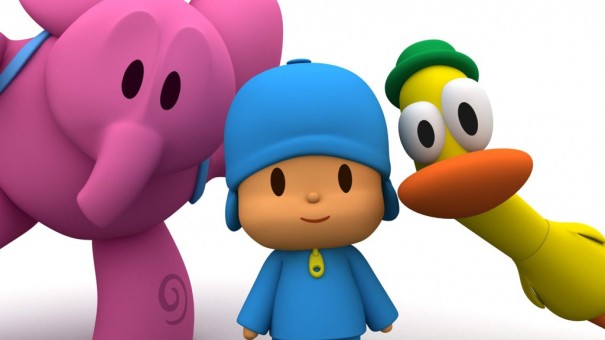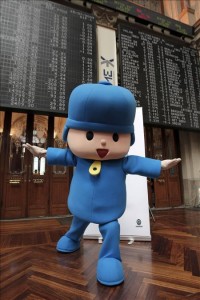Zinkia o la historia de cómo Pocoyó hipnotizó a millones de niños
Zinkia centra su actividad en el mundo de la animación así como en contenidos interactivos tales como juegos de consola y comunidades online. Zinkia, fundada en 2001, con sede en Madrid y oficina comercial en Pekín (China), está presente en más de 100 países y posee una sólida trayectoria internacional difundiendo contenidos audiovisuales y marcas basadas en los mismos. Entre ellos destacan la premiada Pocoyó y la exitosa Shuriken School.
Los inicios de Zinkia se remontan al año 2000 cuando David Cantolla y Colman López fundan una sociedad denominada Junk & Beliavsky a la que posteriormente se incorpora la sociedad Jomaca, propiedad en un 80,14% de José María Castillejo Oriol, actual accionista mayoritario de Zinkia. Posteriormente Junk&Beliavsky se transforma en Zinkia Sitement y ya en 2002 se convierte en Zinkia Entertaiment, primero como sociedad limitada y posteriormente como sociedad anónima con la mayoría del capital en manos de Jomaca-José María Castillejo, quien ‘rompió’ con los auténticos cerebros de la marca David Cantolla y Víctor López (actualmente trabajan en nuevos proyectos en su nueva productora Vodka Capital).
Actualmente, Zinkia la encabeza Castillejo como presidente, y Fernando de Miguel como CEO. Francesca Nicoli está al frente de la producción ejecutiva; Bruno Muniesa, de la producción audiovisual; y Ángel Rascón, de la tecnología. En cuanto al desarrollo de marcas es María Dolan la profesional que se encarga de ello, mientras que la expansión internacional de la empresa está supervisada por Eric Belloso.
La estructura de Zinkia está dividida en tres grandes áreas: producción, comercial y servicios generales. El departamento de producción se subdivide a su vez en tres: producción ejecutiva (pone en marcha y da seguimiento a los nuevos proyectos), audiovisual (responsable de los contenidos de animación en el que participan tres equipos, uno por proyecto y otro para postproducción) y contenidos interactivos en el que se integran los videojuegos y las comunidades online.
En comercial, los profesionales se dividen en dos grupos de trabajo. Uno de ellos se encarga del desarrollo de marcas, explotación, agentes y licenciatarios, estrategia de producto y canal, mientras que el otro es el responsable de expandir las marcas a nivel internacional acorde a lo que marca el primer grupo. Zinkia cuenta además con un equipo de aprobaciones de producto, que supervisa todos los artículos que se lanzan al mercado, y que a su vez cuenta con un equipo de diseñadores dedicados a esta tarea.
En cuanto al área de servicios generales, en él se integran el departamento de marketing y comunicación, el financiero-administrativo, el legal y el de tecnología y sistemas.
La estrategia
Pero, ¿cómo consigue una empresa española abrirse mercado en países de culturas tan distintas y a miles de kilómetros? El detonante para el inicio de la explotación comercial de la marca en prácticamente todos los países es la emisión en televisión en abierto. Zinkia procura tener siempre en cada mercado el mejor socio televisivo posible, incluso a costa de dar el contenido a bajo precio o incluso gratis (práctica habitual en el sector de la animación infantil), y de ofrecer un porcentaje de los ingresos obtenidos en el país por los licenciatarios. Después de iniciada la emisión en televisión en abierto, el objetivo es cerrar acuerdos con los principales motores para la marca: juguetes, DVD y libros. A partir de estos acuerdos llegan los demás licenciatarios, de menor tamaño, y que pueden superar los 50 en los principales mercados.
Para mantener la marca siempre vigente es importante seguir produciendo contenidos alrededor de la marca diversificando la tipología de
contenidos para poder llegar al público objetivo por distintas vías: televisión, cine, internet, móviles, consolas, radio.
Acorde con esta estrategia, Zinkia tiene programado para su estrella Pocoyó un detallado plan de producción hasta 2013 que incluye cortometrajes y largometrajes cinematográficos, juegos para consola, discos musicales, especiales para televisión, comunidad on line, y la producción de nuevas temporadas para televisión.
Las claves del éxito
¿Cómo es posible que una empresa que empezó con mínimos recursos esté ocho años más tarde cotizando en Bolsa y sus productos están situados en mercados de medio mundo?
Una de las razones es la apuesta que desde primer momento sus socios fundadores hicieron por el tramo pre-escolar, un segmento denostado por todas las televisiones y productoras con una carencia total de contenidos en mercados como el español. Zinkia tuvo desde primer momento muy claro que su público objetivo no superaría los 14 años. Partiendo de una premisa meramente familiar, la productora comenzó a desarrollar ideas de entretenimiento magistralmente combinado con elementos educativos y con la transmisión de eso que se ha dado en llamar «valores universales». Otra de las claves de su éxito habría que buscarla en su proyección internacional y en su esfuerzo por integrar contenidos audiovisuales con contenidos interactivos que caminarían mano a mano con un potente desarrollo de marca produciendo sólo contenido propio.
Así pues, ¿de dónde provienen los ingresos? Principalmente de la producción, distribución y venta de contenidos audiovisuales e interactivos en cualquier plataforma (juegos para consolas, móviles, PC y web) y en gran medida también de los royalties que generan lo licenciatarios que explotan las marcas mediante contratos de licencia. Curiosamente, gran parte de los ingresos de la compañía proceden hoy de la explotación de marcas mediante licencias, merchandising y promociones. En cuanto a los ingresos generados por la producción audiovisual, estos proceden en su mayoría de la venta internacional de las producciones a televisiones y otras plataformas (vídeo bajo demanda, Internet, entre otras).
Antes de acometer un proyecto Zinkia plantea un porcentaje de prefinanciación en torno al 60% del coste total de producción a través de la preventa de derechos de distribución/emisión del contenido y/o de los derechos de explotación de la marca. De esta manera se reduce el riesgo de cobertura de costes de producción, y se asegura la visibilidad de los contenidos (preventas a televisiones) y su viabilidad comercial (preventa de derechos).
La producción
En cuanto a producción audiovisual, Zinkia se centra en animación infantil mediante series y largometrajes tanto para cine como para televisión. Para llevarla a cabo, cuentan con cuatro equipos: desarrollo, preproducción, producción y postproducción. De manera continuada existe un equipo básico que cubre estas necesidades, y al iniciarse una producción, los equipos se redimensionan según requiera cada proyecto.
Por lo que a contenidos interactivos se refiere, esta línea de negocio cuenta con dos equipos de desarrollo de nuevos proyectos y tres equipos de producción. Podemos distinguir actualmente dos sub-líneas de negocio dentro esta actividad: la producción y comercialización de videojuegos, y la producción y comercialización de comunidades on line. Los ingresos por contenidos para videojuegos de consola se obtienen a través de la venta internacional del producto final en formato físico o mediante descarga digital, utilizando la intermediación de un Publisher o de un distribuidor. La financiación de la producción se consigue de forma total o parcial del propio Publisher o por los distribuidores, que a cambio participan en los beneficios de la venta del producto. ZINKIA está acreditado como Publisher por Nintendo, por lo que tiene capacidad para acudir al mercado a través de otro Publisher o directamente a través de distribuidores.
La otra pata del negocio a la que mira Zinkia con visión de futuro son las comunidades online para las que están empezando a desarrollar juegos, aventuras gráficas o una mezcla de ambos conceptos, en los que el usuario se encuentra o compite con otros usuarios. En la actualidad, están ultimando el desarrollo de su primera comunidad on line, basada en Pocoyó. La puesta en marcha de esta comunidad (Mundo Pocoyó) a partir del 5 de octubre está avalada por los éxitos de su web, de su blog, de su canal en YouTube, del portal i-Google, y diversos microsites de los principales socios televisivos. El modelo de ingresos se basa principalmente en las suscripciones que permiten acceder sin restricciones a todos los contenidos de la comunidad (sólo un porcentaje reducido es contenido de acceso libre), la utilización de la marca Mundo Pocoyó y la explotación de contenidos y marcas.
Un objetivo fundamental de esta área, más allá de la venta de los contenidos, es el posicionamiento de las marcas de la compañía y alcanzar la máxima rentabilidad a lo largo del tiempo. Para conseguir estos objetivos, se diseñan estrategias de desarrollo de producto, marketing y comunicación de marca.
El 15 de julio de 2009 convirtiéndose en la primera compañía en cotizar en el Mercado Alternativo Bursátil para Empresas en Expansión (MAB) y en la primera compañía que sale a cotizar en España durante los últimos 12 meses. Pero, es ¿rentable la salida de Zinkia-Pocoyo a Bolsa? Según un analista privado en un exhaustivo análisis que publica Hispanidad.com parece que se habrían hinchado las expectativas de crecimiento ya que Pocoyó, pese al proyecto de los dos largometrajes en marcha (incluso, en 3D), podría encontrarse en una fase de estancamiento y maduración de formato según se desprende de las ventas y EBITDA de lo últimos ejercicios.
Por su parte, José María Castillejo, presidente de Zinkia, aseguró “con la salida al mercado Zinkiagana en solidez y transparencia, algo muy importante en nuestro actual momento de expansión internacional. En mi opinión los inversores que han entrado en la OPS harán un gran negocio. Detrás de Zinkia hay un equipo de más de 70 profesionales de primer nivel, un conjunto de propiedades y contratos firmados en territorios por todo el mundo: esa es nuestra mayor garantía de éxito”.
Pocoyó, la gran marca
La serie de Pocoyó está formada por dos temporadas de 52 episodios de 7 minutos cada una. Asimismo, Pocoyó dispone también de su propio cortometraje de 25 minutos de duración, Pocoyó y El Circo Espacial. Ambos contenidos realizados con tecnología de Autodesk Softimage XSI y render con Arnold.
Pocoyó, que originalmente nace como serie de televisión, a día de hoy representa mucho más que eso: una marca de entretenimiento con un concepto multiplataforma de carácter global. Pocoyó se ha convertido en una de las producciones de animación españolas más exitosas, atesorando premios tan prestigiosos como el Cristal de Annecy y el premio BAFTA concedido por la Academia Británica, ambos como Mejor Serie de Animación. Destacan también los tres premios Pulcinella otorgados en el Festival italiano Cartoons on The Bay, el Premio a la Mejor Promo de Animación Promax BDA, el Parent’s Choice obtenido en EE.UU y los dos premios logrados en China: Premio CICDAF, Festival Internacional de la Animación y las Artes Digitales de China (Premio Oficial organizado por el Ministerio de Cultura del Gobierno Central chino) y el Premio de Plata a la Mejor Serie de Animación Extrajera en el Festival de Televisión de Shanghai. Pocoyó es un contenido de animación con esencia didáctica y divertida, donde la curiosidad de su joven personaje, acompañado de sus inseparables amigos, Elly, Pato, Loula y Pajaroto, Pulpo, Pajarito, y Valentina entre otros generan multitud de historias en un mundo creado para él, donde se desarrollan todo tipo de situaciones en un mundo de colores, formas y música con lenguaje visual impactante. La serie muestra el descubrimiento que realiza un niño pequeño del mundo que le rodea.
Pocoyó se emite o se ha emitido en las televisiones de: Australia (ABC), Bélgica (VRT), Canadá (Tree House y Tele Québec), Chipre (CYBC), Finlandia (YLE), Francia (Nick Junior/M6), Grecia (Alter Channel), Alemania (KIKA), Islandia (ICB), Italia (RAISAT YOYO), Irlanda (RTE), Israel (Baby TV), Japón (Wow Wow), Corea (EBS), Latino América (Discovery), México (Televisa), Oriente Medio (Gula & MBC), Nueva Zelanda (TVNZ), Pan-Asia (Disney Channel), Portugal (RTP y Panda), España (TVE y Boomerang), Sudáfrica (M-Net), Escandinavia (Disney), Eslvovenia (RTE), Reino Unido (Channel y c-ITV), Estados Unidos (Discovery y PBS), Ecuador (Telecuador), China (BTV), America2 (Argentina), Televicento (Honduras) y RTVC Señal (Colombia).
El DVD de Pocoyó se ha distribuido a nivel mundial en: Australia y Nueva Zelanda, Benelux, Canadá, Francia, Oriente Medio, Grecia, Japón, Corea del Sur, Reino Unido, Portugal, España, Estados Unidos, Alemania, México, países de Centroamérica, Brasil y Argentina.
¿Te gustó este artículo?
Suscríbete a nuestro NEWSLETTER y no te perderás nada.






